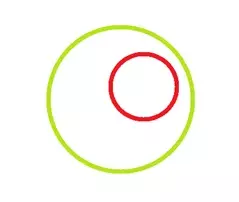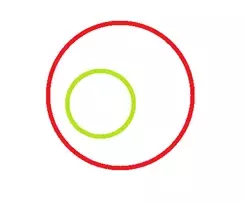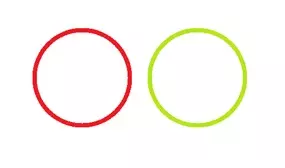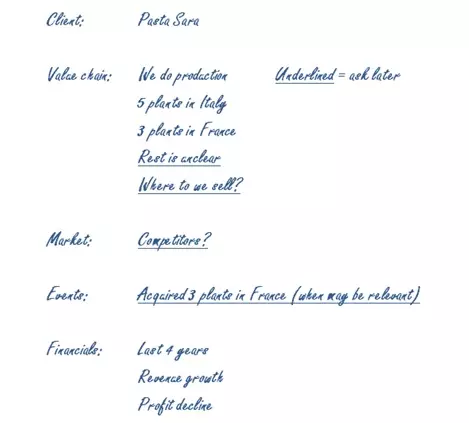Correctly identifying the problem is the first step to successfully solving a case. This might seem obvious - surely one has to know what a question is in order to answer it correctly? However, failing the identify the problem derails far too many case interviews before they have even gotten started. Many otherwise-promising candidates lose out on jobs as they miss the whole point of the case.
In light of this, MyConsultingCoach has developed a structured, step-by-step approach to identifying the problem. This approach should make sure that you are addressing the correct question every time, giving you the best possible chance of cracking your case and impressing your interviewer.
This article provides an outline of our method, which will get you started with identifying the problem in your case practice. In our MCC Academy, we have a comprehensive video lesson, which is the gold-standard resource for this topic. This goes through our method to identify the problem in greater detail than is possible here and includes more examples to help you get to grips with the material more quickly.
Prompts
Case prompts can vary immensely. Some will be straightforward, with a clear and specific problem. For example:
"Our client, a supermarket, has seen a decline in profits. How can we bring them up?"
Often, though, you'll be given rather more open ended questions and/or questions asking about unfamiliar industries where you are unlikely to have much pre-existing knowledge.
For example:
"How much would you pay for a banking license in Ghana?"
Or, alternatively :
"What would be your key areas of concern when setting up an NGO?"
Whatever prompt you get, don't let it panic you. Remember, you aren't being assessed on your previous knowledge - nobody expects you to have read up on the Ghanaian banking system just in case it came up. Interviewers care less about what you happen to know than they do about your ability to ask smart questions. Difficult case prompts are a test in themselves and assess your abilities to prioritise, to cope with ambiguity, to learn quickly and to impose structure - all whilst managing your own stress.
Four Steps to Identify the Problem
Whether the prompt seems straightforward or difficult and ambiguous, you can apply the same method to make sure that you correctly identify the problem.
Join thousands of other candidates cracking cases like pros
At MyConsultingCoach we teach you how to solve cases like a consultant Get startedFrom start to finish, we can break down the process into four key steps. This might all seem like quite a lot to remember on first reading. However, with a little practice, this method will soon become second nature and you will be able to correctly identify the problem for any given case in a few minutes.
1. Listen to the case prompt and take tidy notes
This might seem obvious, but paying attention and taking notes you can actually read to refer back to is crucial - not just for identifying the problem, but for your subsequent analysis as well. Don't make any assumptions straight off the bat - just jot down the facts.
2. Engage the interviewer and ask key questions
Now, it's time to respond to the interviewer. We can break this response down into two areas:
2a. Engage the interviewer
Your first words should engage your interviewer. By this, we mean that you should try to establish a rapport with your interviewer and to demonstrate your interest in the problem. It is important to show that you are enthusiastic and actually enjoy tackling tricky cases - after all, you are supposed to want to do it full time!
2b. Clarify unclear information in the prompt
After engaging the interviewer, it's time to ask some questions - not too many! It is important to ask questions sparingly and in a structured, thoughtful way, rather than just rattle off a dozen at once.
We cannot stress the importance of these questions enough. You must actually understand the prompt to have a chance of identifying the problem and you must identify the problem to solve the case. It will do you no good to make a mess of a whole case study because you didn't want to admit that you weren't sure of something at the start!
There are two kinds of question which you might need to ask:
- First, you might need to clarify relatively simple matters, such as the definitions of any terms you are not familiar with. Similarly, you might need to clarify the scope of the problem and the timeframe in which you are operating. For instance, it may be that the client company is on the edge of bankruptcy and will go bust within a couple of months if things can't be turned around - meaning you will be looking for solutions which will be effective in the immediate term!
- Second, you will need to ask some questions to get more detail about how the client company functions and the business environment it exists within. Precisely what you need to ask will very much depend on the specific case. For example, you might want to ask about the company's value chain or how its market share has been changing over time. Whichever questions you do ask, though, you should make sure to be specific and have a clear rationale for each.
3. Formulate your hypothesis on the problem
Now that you have gathered all the information you need, you should be able to form an hypothesis on what the problem actually is.
To formulate this hypothesis, ask yourself the key question:
What is the single, key, most important success criterion for the client?
You can test this hypothesis by asking yourself two follow up questions:
If this problem is solved, will it make the project successful?
If it is not solved, will this problem jeopardize the project?
If your hypothesis meets both these conditions, it is probably the correct one and you can move on to validate it.
4. State the problem, get feedback and refine if necessary
The final step to identify the problem is to confirm that your hypothesis is correct. This is crucial - do not be tempted to just assume you are correct and skip ahead to the analysis without being sure. As we will see in the next section, mistakes are easy to make and must always be guarded against.
Here, you should briefly restate the problem to the interviewer in your own words. Be sure to take a top down approach (our articles on CEO level communication and the Pyramid Principle might be useful here) and to integrate what you have learnt from your questions to the interviewer. Don't just repeat the interviewer's own words back to them like a robot! Re-phrasing and integrating what you have been told show that you have been listening and that you understand what has been said.
Everything you need in one place
All the most up-to-date resources delivered as a MBA course Learn moreAsk the interviewer to validate your hypothesis - that is, to say if you have gotten the problem right. If they say you are correct, you can move on to start structuring the problem and begin your analysis. If not, you can adjust your hypothesis and try again, iterating until you arrive at the correct problem. This way, you will be sure you will always be sure you have successfully identified the problem before you go on to analyse it.

Common mistakes
Candidates tend to fall into the same traps over and over again. Even with our step-by-step scheme to help you out, these can be easy mistakes to make and you should keep them in mind so as to avoid making costly errors. We can group these mistakes together into three categories:
Being too narrow

It is easy to identify too narrow a problem. This will mean that you address only a subset of the client's main issue. For example, you might focus only on growing a company's profitability in the short term, without giving sufficient consideration to how the company can grow in the medium to long term.
This kind of mistake can be avoided by being sure to ask your interviewer for clarification if there is any ambiguity in the scope of the case prompt (see 2b, above). You should also ask yourself whether an answer to the problem you have identified would really give the client a complete answer to their concerns.
Being too broad

It is also possible to be too broad. Identifying too broad a problem will lead you to try to understand too much and provide a very general analysis which will be largely irrelevant to the client's actual issue. This will make very inefficient use of your time and you will quite likely not reach a solution within the timeframe of the interview.
Just as with being too narrow, you can avoid too broad an approach by being sure to ask you interviewer questions about any ambiguity and by asking yourself whether the client will actually find this answer to the question you are identifying useful. Is what you are doing really necessary to address their key concern? Our article on taking a hypothesis driven approach to problems is also particularly useful here in making sure you keep your eye on the main problem and avoid unnecessary analysis.
Addressing the wrong problem

You might think that one would have to be some kind of idiot to end up tacking completely the wrong problem and that this won't happen to you. However, case prompts will often obscure the real problem. This might very well be intentional on the part of the interviewer as a way to test you (after all, interviewers in all industries will make use of trick questions) It will require real thought and attention to make sure you don't embark down the wrong path. This can be the case for working consultants as well, as clients will often have a poor understanding of what is causing their company's issues and inadvertently attempt to push consultants in the wrong direction.
Forget outdated, framework-based guides...
Interviewers are sick of seeing candidates miss the point and make the same old mistakes. Stand out from the crowd by learning to think like a working consultant! Get startedExample
Now that we have learnt how we should go about identifying the problem in principle, it's time to put these ideas into practice. Let's see how a case might be tackled incorrectly and how our step-by-step approach can help improve matters. As an example, let's say your interviewer gives you the following prompt:
Our client, Pasta Sara, is a major producer of dried pasta. Pasta Sara is based in Italy and manages a network of 5 manufacturing plants, spread across the country. They have also acquired a company with 3 manufacturing plants in France. Pasta Sara has seen steady revenue growth but a slow, gradual decrease in profitability in the last 4 years. How can we help them?
Unsuccessful Candidate
We'll start with a candidate who does some things corectly, but who has also made some fatal mistakes. See if you can pick out what they get right and wrong:
Candidate: So the problem we’re trying to solve is to boost Pasta Sara’s profit margin. I’d like to ask a few clarifying questions before proceeding to structuring the problem. Is that ok?
Interviewer: Go ahead
Candidate: I’d like to know if this decrease in profitability was transversal to our operations or focused on a specific geographic area? This could probably help me identify specific issues there. Also, are there any trends I should be aware of in this industry? Additionally…
Interviewer: Well regarding your first question…
Candidate: Thank you for your answers. I’d like to take 30 seconds to structure my approach to this problem if that’s ok with you
Interviewer: Go ahead
Okay, so what did the candidate do correctly? Well, they at least attempted (however unsuccessfully) to pinpoint the problem. They were also explicit about what they were doing and provided a rationale for their questions.
However, the candidate also made some serious errors. First, as regards engaging the interviewer, they didn't make an effort to show interest and establish a rapport. The candidate then jumped the gun by attempting to define the problem too early, before asking for any clarification or more information. They also didn't bother to check with the interviewer that they had identified the problem correctly.
Regarding the questions the candidate did ask, they barraged the interviewer with a whole list of queries. Not only were these questions too numerous, but they were also too vague; not being structured or targeted enough for the answers to actually be useful.
As a result of all this, the candidate totally missed the problem they were supposed to be solving. This means that (barring a miracle) their analysis will also fail to address the client's problem, so they will fail to solve their case and (barring another miracle) fail to get the job.
Successful Candidate
So, how can we improve on this unsuccessful candidate's performance? Let's see a more successful candidate apply our step-by-step process.
First, they listen carefully and make notes - which end up looking something like the following. These notes capture all the relevant information and our candidate has underlined pieces of information which they will need to ask about.
Now, our candidate replies to the interviewer:
“Thank you for the opportunity to look into this issue for our client. It sounds like an interesting case!”
“To ensure I’m addressing the right issues and to familiarize myself with the problem, I would like to ask three brief questions”
“First, could you let me know a bit more about our client’s business model? Which activities do they perform -is it only production, or do they also control distribution etc.? Second, I would like to understand who their main clients are and, third, I was wondering who their key competitors are and what their market share is? This would allow me to better tailor my approach to the problem”
Note that our candidate starts by engaging interviewer and expressing interest in the case. They make what they are doing explicit before asking a small number of questions aimed only at understanding the issue, rather than jumping straight into trying to solve the case. These questions are very structured and specific, so that the answers will be genuinely informative. They are also backed by a rationale explaining their relevance.
Looking for an all-inclusive, peace of mind program?
Choose our mentoring programs to get access to all our resources, a customised study plan and a dedicated experienced MBB mentor Learn moreAfter the interviewer answers their questions, our candidate moves on to generate and test an hypothesis as to what the problem is.
Thank you for answering my questions. Before proceeding to addressing our client’s problem, I’d like to validate my understanding of that problem.
Our client is a pasta manufacturer operating in Italy and France. The client has asked for our support because - despite strong revenue growth over the last few years - profits did not grow in line with revenues, resulting in a declining profitability ratio.
Our client’s objective is to improve this profitability ratio.
Is this correct? Is there any other objective we should consider?
After securing positive feedback from the interviewer, our client is ready to move on to creating a structure and analyzing the problem, safe in the knowledge that this is indeed the correct problem and thus that they are that bit closer to landing their dream consulting job.
Takeaway
By now, you should have a pretty good idea on how to go about identifying the problem. Remember that, for a truly comprehensive look at this issue, you should see our video lesson in the MCC Academy. This goes through the whole process of identifying the problem in more detail and with more examples than can be packed into this kind of article.
Once you feel you understand how to identify the problem, you should move on to learn how to build a priority driven structure for it and to begin your analysis. Remember that you should be practising your skills as you learn them and that you can do so using our free case bank, as well as with the problems included in MCC Academy. This kind of active learning makes it much faster to get to grips with all the material and get a head start on really impressing your interviewer!
Find out more in our case interview course
Ditch outdated guides and misleading frameworks and join the MCC Academy, the first comprehensive case interview course that teaches you how consultants approach case studies.





